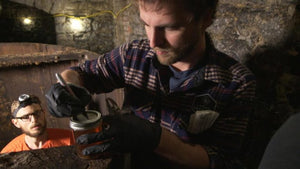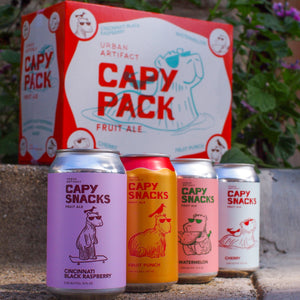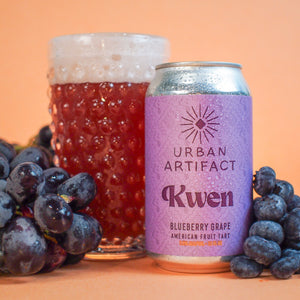Big news! We are fermenting a beer that is a first in the annals of brewing history: It is being made from yeast that is approximately 150 years old, “wild caught” from a wooden fermenting tank miraculously preserved in a long-forgotten lagering cellar. It was recently discovered in Cincinnati.
The beer, which has not yet been named, will be revealed at an exclusive tapping event we’re doing on Friday, November 9, 2018. Provided the finished beer meets our standards, it will be bottled and released to the public later in 2018 or early 2019.
This is an unprecedented event! While beers have been recreated by analyzing and reconstructing the DNA profile of a found bottle of old beer, no modern-day beer has ever been made from original brewer’s yeast, of unknown origin, scraped off a fermenting tank that dates back more than 150 years.
“It would be hard to overstate the statistical anomaly of this project,” says Bret Kollmann Baker, our Director of Brewing Operations. “Finding a vat that’s this old and still intact is something I never imagined could happen. But on top of that, harvesting a yeast off of it that would prove to be viable—it’s unfathomable.” He adds, “It’s highly unlikely anything like this could ever happen again.”
Kollman Baker got wind of the rumored fermenting tank from our friend Michael Morgan, an author and entrepreneur who helped blaze Cincinnati’s Brewing Heritage Trail. “They found cellars on Race Street and apparently there’s this big wooden vat,” Kollmann Baker recalls Morgan telling him. Kollman Baker was skeptical. But Morgan, Cincinnati’s pre-eminent beer historian, had ascertained that a tenement building in the Over-the-Rhine neighborhood of Cincinnati—an epicenter of 19thcentury beer-making, just north of downtown—stood atop stone-vaulted lagering cellars used by some of the city’s most prominent beer barons.
The cellars were built in 1855, before electricity and refrigeration were available. “I thought we’d maybe find a pile a disintegrating wood,” says Kollmann Baker, who, through Morgan, got access to the cellar. “It had been sealed off for more than a hundred years.” To their shock and delight, the fermenting tank was intact. “There is nothing in the country that we know of with that kind of age on it.”
Urban Artifact was the natural go-to for Morgan’s news of the 2017 discovery since we specialize in beers made with wild-caught yeast, and we’re known for bringing old techniques and artifacts into modern-day, hyper-local brewing.
Kollmann Baker brought Morgan on board to provide historical context to the project of trying to re-animate a beverage from the ancient vat. Though he was aware of the extremely low likelihood of it happening, “it was a follow-your-folly thing,” he says. Aware of the historical significance of the project, they invited Seven/Seventy-Nine Video, an award-winning production company, to document the process. (A short film is in production; a rough cut of the trailer can be viewed at tinyURL.com/UAYeast).
“Walking into the cold, dark cellar was humbling,” says Kollmann Baker. “It was heavy to have an experience that no one is going to be able to repeat, maybe ever.” Michael Morgan, who was himself dubious that a wooden vat built before the Civil War could really still be in one piece, puts more of a fine point on it. “When we walked in,” Morgan says, “I thought, ‘Holy shit.”
Approximately 60 yeast scrapings were gathered from inside and outside the vat, its spigot, and even the cellar’s walls, and captured in jars of wort (a malt infusion; a sort of pre-beer beer). We fermented them for six months and then cracked them open. Well, most of them. Some appeared too scary to unleash. “A few of them had turned black,” recalls Morgan, who cautiously sampled drops with the Urban Artifact brewers. “There was a mild freakout from one of the testers who jumped up to wash his hands.”
Three samples seemed promising, so we shipped them to Omega Yeast, a craft-beer resource and microbiology lab in Chicago. When results came in, Kollman Baker and Morgan drove to the Windy City to hear the news. “We didn’t want to hear it on the phone,” Kollmann Baker says. “Making the road trip to hear the results was like waiting until the birth of your child to find out its gender.”
We were prepared for bad news. The needle-in-the-haystack nature of the project so far seemed unlikely to continue to produce positive outcomes. “Yeast is a living organism,” he explains. “It needs to eat. Some can live on wood sugar, but brewer’s yeast can’t. So there was a great possibility that our project would end there.”
It didn’t. Two of the three yeast strains proved to be viable brewer’s yeast. The more promising of the two was a strain that had never been discovered before. “The pedigree may be royal,” jokes Morgan. His research discovered that a group of brewers had leased the lagering cellar space; their names are well known to beer aficionados: Christian Moerlein; Koehler (which later became Hudepohl) and Kauffman, among others. “They would all become the major brewers in Cincinnati,” says Morgan.
The project continues. We are presently fermenting two barrels of the historic beer in preparation for the November 9 tapping party for 400 guests. “We still don’t know that we’ll have a great product,” says Kollmann Baker. “But this adventure is a microcosm of who Urban Artifact is as a brewery. We can’t not do it.”








